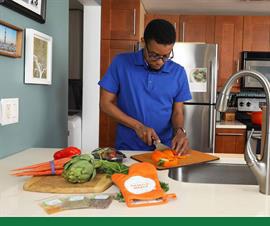A Recipe for Safely Preparing Food at Home during COVID-19
Apr 28, 2020
Ashley Eisenbeiser, MS, CFS, Senior Director, Food and Product Safety Programs, FMI
 What’s for dinner? It is one of those age-old questions. During the COVID-19 pandemic, the question has evolved and it’s not just what’s for dinner, but what’s for breakfast? Lunch? Snack? Dessert? Some families may be cooking more at home and the food that is in the fridge or pantry will dictate the answer. For others, food delivery and takeout has become the new normal. No matter what the answer is to that question, there is a common theme of where dinner will be…at home.
What’s for dinner? It is one of those age-old questions. During the COVID-19 pandemic, the question has evolved and it’s not just what’s for dinner, but what’s for breakfast? Lunch? Snack? Dessert? Some families may be cooking more at home and the food that is in the fridge or pantry will dictate the answer. For others, food delivery and takeout has become the new normal. No matter what the answer is to that question, there is a common theme of where dinner will be…at home.
Whether shopping in a store, receiving groceries at your doorstep, or preparing a meal at home, food safety is just as important today, as it was before the COVID-19 pandemic. Families can follow the recipe below for simple food safety steps to help protect themselves from foodborne illness.
Step 1: Shop Safely
Step 2: Store Food Safely
Step 3: Prepare Food Safely
Step 4: Enjoy Food Safely
When you are spending more time in the kitchen cooking for loved ones, remember the food safety basics to keep your family healthy: Clean – Separate – Cook – Chill.
Family Meals COVID-19 Tips
 What’s for dinner? It is one of those age-old questions. During the COVID-19 pandemic, the question has evolved and it’s not just what’s for dinner, but what’s for breakfast? Lunch? Snack? Dessert? Some families may be cooking more at home and the food that is in the fridge or pantry will dictate the answer. For others, food delivery and takeout has become the new normal. No matter what the answer is to that question, there is a common theme of where dinner will be…at home.
What’s for dinner? It is one of those age-old questions. During the COVID-19 pandemic, the question has evolved and it’s not just what’s for dinner, but what’s for breakfast? Lunch? Snack? Dessert? Some families may be cooking more at home and the food that is in the fridge or pantry will dictate the answer. For others, food delivery and takeout has become the new normal. No matter what the answer is to that question, there is a common theme of where dinner will be…at home. 

 Industry Topics address your specific area of expertise with resources, reports, events and more.
Industry Topics address your specific area of expertise with resources, reports, events and more.
 Our Research covers consumer behavior and retail operation benchmarks so you can make informed business decisions.
Our Research covers consumer behavior and retail operation benchmarks so you can make informed business decisions.
 Events and Education including online and in-person help you advance your food retail career.
Events and Education including online and in-person help you advance your food retail career.
 Food Safety training, resources and guidance that help you create a company food safety culture.
Food Safety training, resources and guidance that help you create a company food safety culture.
 Government Affairs work — federal and state — on the latest food industry policy, regulatory and legislative issues.
Government Affairs work — federal and state — on the latest food industry policy, regulatory and legislative issues.
 Get Involved. From industry awards to newsletters and committees, these resources help you take advantage of your membership.
Get Involved. From industry awards to newsletters and committees, these resources help you take advantage of your membership.
 Best practices, guidance documents, infographics, signage and more for the food industry on the COVID-19 pandemic.
Best practices, guidance documents, infographics, signage and more for the food industry on the COVID-19 pandemic.
